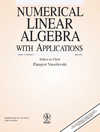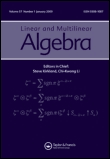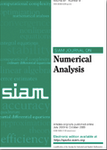
NUMERICAL LINEAR ALGEBRA WITH APPLICATIONS
Scope & Guideline
Advancing the Frontiers of Numerical Methods
Introduction
Aims and Scopes
- Numerical Methods for Linear Algebra:
The core focus is on developing efficient numerical algorithms for solving linear algebra problems, including systems of linear equations, eigenvalue problems, and matrix factorizations. - Applications in Scientific Computing:
The journal emphasizes the application of numerical linear algebra techniques in scientific computing, showcasing methods that solve real-world problems in engineering, physics, and data analysis. - Advanced Algorithms and Techniques:
Research often explores advanced algorithms, such as Krylov subspace methods, preconditioning techniques, and tensor decomposition methods, which enhance computational efficiency and accuracy. - Interdisciplinary Approaches:
The journal encourages interdisciplinary research, integrating concepts from optimization, machine learning, and data science, reflecting the growing importance of numerical linear algebra in these fields. - Theoretical Foundations:
Contributions also include theoretical investigations that provide new insights into the properties of numerical methods, including convergence analysis and error estimation.
Trending and Emerging
- Tensor Decomposition Methods:
There is a growing trend in the exploration of tensor decomposition techniques, particularly in applications to data science and machine learning, indicating an interest in high-dimensional data analysis. - Data-Driven Algorithms:
The rise of data-driven approaches is evident, with an increasing number of studies focusing on algorithms that leverage data to enhance the performance of numerical methods. - Adaptive and Robust Methods:
Emerging themes include adaptive algorithms that dynamically adjust to problem parameters and robust methods that ensure stability and accuracy in the presence of uncertainties. - Applications in Machine Learning and AI:
The intersection of numerical linear algebra with machine learning and artificial intelligence is becoming increasingly prominent, as researchers seek to apply linear algebra techniques to optimize learning algorithms. - High-Performance Computing Techniques:
With advancements in computational power, there is a trend towards high-performance computing strategies that utilize parallel processing and GPU acceleration for large-scale numerical problems.
Declining or Waning
- Traditional Matrix Factorizations:
There has been a noticeable decline in publications focusing solely on traditional matrix factorizations such as LU and QR, as newer methods and variations have emerged that address more complex problems. - Basic Linear Solvers:
Research on classical linear solvers without significant enhancements or adaptations has become less frequent, indicating a shift towards more sophisticated techniques that offer improved performance in specific applications. - Static Analysis Techniques:
Static analysis methods that do not incorporate dynamic or adaptive elements are seeing reduced interest, as researchers increasingly explore approaches that can adjust based on problem characteristics.
Similar Journals

CALCOLO
Exploring the Depths of Algebra and Number TheoryCALCOLO is a prestigious academic journal published by Springer-Verlag Italia SRL, focusing on the fields of Algebra, Number Theory, and Computational Mathematics. Established in 1964, this journal has made significant contributions to advancing mathematical theory and applications. It holds a commendable Impact Factor and ranks in the Q1 quartile for Algebra and Number Theory, underscoring its importance and influence in the field. With a Scopus Rank of #17 out of 119 in Algebra and Number Theory, CALCOLO is recognized for publishing high-quality research that propels the discipline forward. Researchers and professionals in the mathematical community will find CALCOLO an essential resource, providing access to pioneering studies and fostering collaborations. While the journal currently does not offer an open access option, it continues to engage with emerging topics and innovative methodologies, ensuring it remains at the forefront of mathematical research through 2024 and beyond.

ADVANCES IN COMPUTATIONAL MATHEMATICS
Driving Progress in Computational MethodologiesADVANCES IN COMPUTATIONAL MATHEMATICS, published by Springer, is a leading international journal dedicated to the dynamic and rapidly evolving fields of Applied Mathematics and Computational Mathematics. With an impressive Q1 ranking in both categories as of 2023, the journal serves as a vital platform for researchers and professionals to disseminate innovative methodologies and computational techniques that address complex mathematical challenges. Operating since 1993 and continuing to contribute substantially to the academic landscape through 2024, it boasts a robust reputation within the mathematics community, underscored by its Scopus rankings—#230 out of 635 in Applied Mathematics and #80 out of 189 in Computational Mathematics. This journal, based in the Netherlands, emphasizes cutting-edge research while offering a wealth of access options to facilitate scholarly communication. As such, ADVANCES IN COMPUTATIONAL MATHEMATICS stands as an essential resource for anyone interested in the forefront of computational techniques and mathematical theory.

Journal of Mathematics and Computer Science-JMCS
Where Mathematics Meets Technology: Pioneering Research AwaitsJournal of Mathematics and Computer Science (JMCS) is a leading academic journal published by INT SCIENTIFIC RESEARCH PUBLICATIONS, dedicated to advancing research in the interdisciplinary realms of mathematics and computer science. Established with a commitment to open science, JMCS provides a platform for innovative studies and original research, covering topics in computational mathematics, computational mechanics, and various applications of computer science. The journal, indexed in prominent databases, has achieved notable rankings, including Q3 in Computational Mathematics and Q2 in Mathematics (miscellaneous) as of 2023, highlighting its influence and relevance in the academic community. With an emphasis on fostering collaboration among researchers, professionals, and students, JMCS serves as both a resource and a conduit for groundbreaking discoveries. The journal encourages submissions that push the boundaries of knowledge and offers accessible options for sharing your work with the global research community.

BIT NUMERICAL MATHEMATICS
Advancing the Frontiers of Numerical Analysis.BIT Numerical Mathematics, published by Springer, is a prestigious journal in the field of Applied Mathematics and Computational Mathematics, with an ISSN of 0006-3835 and an E-ISSN of 1572-9125. Since its inception in 1961, the journal has become a cornerstone for researchers and practitioners alike, offering high-quality articles that advance the understanding and application of numerical methods in various domains. With its impressive 2023 rankings in the Q1 category for multiple disciplines—including Applied Mathematics, Computational Mathematics, Computer Networks and Communications, and Software—the journal consistently showcases significant contributions to the mathematical community. Although it does not offer Open Access, BIT Numerical Mathematics continues to reach a vast audience through its rigorous peer-reviewed content. As it converges towards 2024, the journal remains committed to publishing cutting-edge research that addresses fundamental challenges in numerical analysis and algorithm development, ensuring its relevance in an ever-evolving scientific landscape.

International Journal of Mathematics and Computer Science
Bridging Theory and Application in Mathematics and ComputingThe International Journal of Mathematics and Computer Science (ISSN: 1814-0424, E-ISSN: 1814-0432), published by Lebanese University, serves as a vital platform for disseminating innovative research and advancements in the fields of mathematics and computer science. With a compelling range of topics including Algebra, Applied Mathematics, Computational Mathematics, and Statistical Analysis, this journal caters to a broad audience of researchers, professionals, and students. Spanning the years from 2017 to 2025, it has established a presence in several key quartiles, including Q3 rankings in Applied Mathematics and Computational Mathematics, and a Q4 ranking in Algebra and Number Theory. While currently not an open-access journal, it provides valuable insights through its rigorous peer-reviewed process, enhancing its relevance in both theoretical and applied domains. Furthermore, its presence in Scopus rankings reflects its commitment to quality, making it an essential resource for anyone looking to explore the intersection of mathematics and computer science.

COMPUTATIONAL MATHEMATICS AND MATHEMATICAL PHYSICS
Advancing the Frontiers of Computational DiscoveryCOMPUTATIONAL MATHEMATICS AND MATHEMATICAL PHYSICS is a prestigious journal published by PLEIADES PUBLISHING INC, dedicated to advancing the fields of computational mathematics and mathematical physics. With an ISSN of 0965-5425 and an E-ISSN of 1555-6662, the journal has established its importance within the academic community since its inception in 1985. It is classified in the third quartile (Q3) for computational mathematics in 2023, and while currently it does not offer open access options, it remains a valuable resource for researchers seeking to disseminate their findings and engage with cutting-edge developments in the field. The journal encompasses a broad spectrum of topics, including numerical analysis, applied mathematics, and the intersection of physics and computational techniques, highlighting its relevance in addressing complex problems in both theoretical and applied contexts. Scholars will find a platform that not only promotes rigorous research but also encourages collaboration and innovation within the scientific community.

Numerical Algebra Control and Optimization
Transforming Theoretical Concepts into Practical SolutionsNumerical Algebra Control and Optimization is a distinguished journal published by the American Institute of Mathematical Sciences (AIMS), dedicated to advancing the fields of algebra, applied mathematics, and optimization techniques. With an ISSN of 2155-3289 and E-ISSN 2155-3297, the journal provides a vital platform for researchers to disseminate significant findings and innovative methods in numerical analysis and its applications. Operating since 2011 and continuing to 2024, the journal holds a prominent position in the academic community, evidenced by its 2023 Quartile 3 ranking in categories such as Algebra and Number Theory, Applied Mathematics, and Control and Optimization. With robust Scopus rankings reflecting the journal's impact—93rd percentile in Algebra and Number Theory, 65th in Applied Mathematics, and 61st in Control and Optimization—it serves as a key resource for scholars striving to push the boundaries of mathematical research. While it remains a subscription-based journal, its commitment to scholarly excellence positions it as an essential reference for professionals, researchers, and students seeking to explore the intricate world of numerical algebra and optimization.

LINEAR & MULTILINEAR ALGEBRA
Unlocking New Dimensions in Algebraic StudiesLINEAR & MULTILINEAR ALGEBRA, published by Taylor & Francis Ltd, is a distinguished academic journal that has been contributing to the field of mathematics since 1973. With an ISSN of 0308-1087 and an E-ISSN of 1563-5139, this journal focuses on innovative research in algebra and number theory, reinforcing its standing as a vital resource for mathematicians worldwide. Currently ranked in the Q2 quartile of its category, and holding an impressive rank of 13 out of 119 in Scopus, it occupies a prominent position in the field, commanding a significant 89th percentile. The journal aims to disseminate groundbreaking research, critical reviews, and theoretical advancements, making it an essential platform for both established researchers and emerging scholars. With a publishing horizon stretching to 2024, LINEAR & MULTILINEAR ALGEBRA is poised to continually influence the mathematical community while fostering a deeper understanding of linear and multilinear frameworks.

SIAM JOURNAL ON NUMERICAL ANALYSIS
Empowering Research with Cutting-Edge TechniquesSIAM Journal on Numerical Analysis, published by SIAM Publications, is a leading academic journal dedicated to the rigorous exploration of numerical methods and algorithms across applied and computational mathematics. Since its inception in 1969, this journal has played a pivotal role in advancing the field, achieving a distinguished impact factor that places it in the Q1 quartile for Applied Mathematics, Computational Mathematics, and Numerical Analysis as of 2023. With Scopus rankings reflecting its high influence (Rank #102 in Applied Mathematics and Rank #16 in Numerical Analysis), this journal serves as an essential resource for researchers, professionals, and students aiming to stay abreast of cutting-edge developments in numerical methods. The journal's comprehensive scope covers theoretical advancements, implemented algorithms, and applications, making it indispensable for those engaged in high-level quantitative research and practice. Readers can access a wealth of innovative studies and insights, fostering a deeper understanding of numerical analysis techniques and their practical applications.

Carpathian Journal of Mathematics
Navigating the Frontiers of Mathematical ScienceCarpathian Journal of Mathematics, published by NORTH UNIV BAIA MARE in Romania, is an esteemed research platform dedicated to the diverse and evolving field of mathematics. With an impressive Q2 ranking in the 2023 Mathematics (miscellaneous) category, this journal serves as a vital resource for researchers and practitioners alike, offering insights into both theoretical and applied mathematics. Spanning from its inception in 2003 to the anticipated contributions in 2024, it has established itself as a reputable source with a significant impact, reflected in its Scopus rank of #84/399 in General Mathematics, positioning it in the 79th percentile. Although it operates without open access, the journal ensures that subscribers, institutions, and readers enjoy rigorous peer-reviewed content that pushes the boundaries of mathematical inquiry. From algebra and number theory to applied mathematics and mathematical modeling, the Carpathian Journal of Mathematics stands as a beacon for innovation and scholarly dialogue, catering to an audience eager to contribute to and learn from the mathematical sciences.